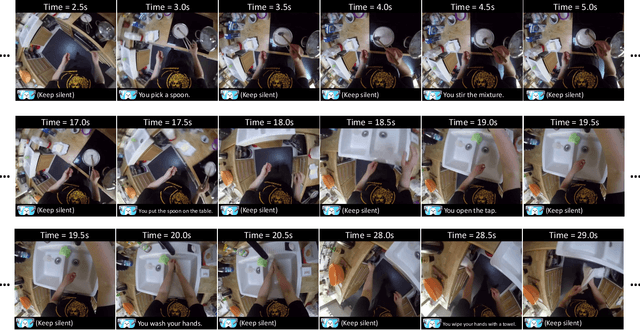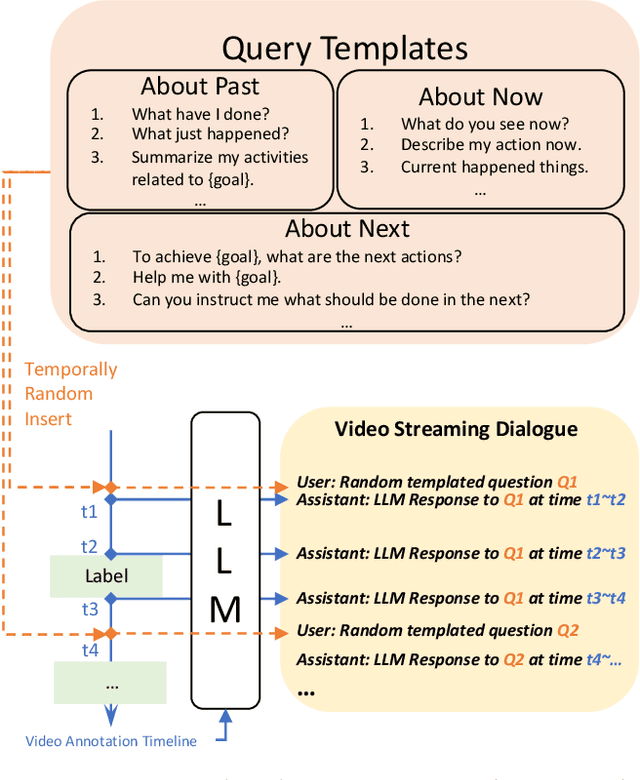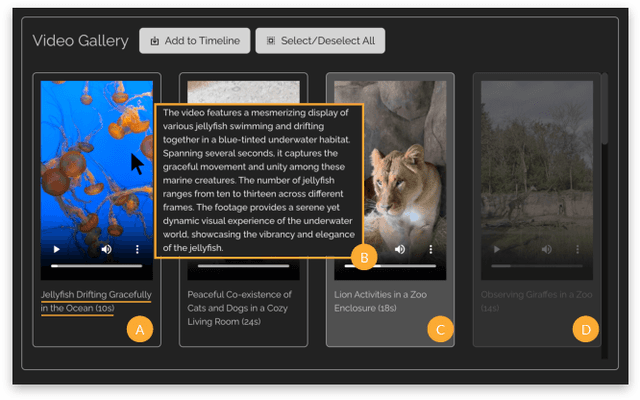Zhaoyang Lv
DGS-LRM: Real-Time Deformable 3D Gaussian Reconstruction From Monocular Videos
Jun 11, 2025Abstract:We introduce the Deformable Gaussian Splats Large Reconstruction Model (DGS-LRM), the first feed-forward method predicting deformable 3D Gaussian splats from a monocular posed video of any dynamic scene. Feed-forward scene reconstruction has gained significant attention for its ability to rapidly create digital replicas of real-world environments. However, most existing models are limited to static scenes and fail to reconstruct the motion of moving objects. Developing a feed-forward model for dynamic scene reconstruction poses significant challenges, including the scarcity of training data and the need for appropriate 3D representations and training paradigms. To address these challenges, we introduce several key technical contributions: an enhanced large-scale synthetic dataset with ground-truth multi-view videos and dense 3D scene flow supervision; a per-pixel deformable 3D Gaussian representation that is easy to learn, supports high-quality dynamic view synthesis, and enables long-range 3D tracking; and a large transformer network that achieves real-time, generalizable dynamic scene reconstruction. Extensive qualitative and quantitative experiments demonstrate that DGS-LRM achieves dynamic scene reconstruction quality comparable to optimization-based methods, while significantly outperforming the state-of-the-art predictive dynamic reconstruction method on real-world examples. Its predicted physically grounded 3D deformation is accurate and can readily adapt for long-range 3D tracking tasks, achieving performance on par with state-of-the-art monocular video 3D tracking methods.
4DGT: Learning a 4D Gaussian Transformer Using Real-World Monocular Videos
Jun 09, 2025Abstract:We propose 4DGT, a 4D Gaussian-based Transformer model for dynamic scene reconstruction, trained entirely on real-world monocular posed videos. Using 4D Gaussian as an inductive bias, 4DGT unifies static and dynamic components, enabling the modeling of complex, time-varying environments with varying object lifespans. We proposed a novel density control strategy in training, which enables our 4DGT to handle longer space-time input and remain efficient rendering at runtime. Our model processes 64 consecutive posed frames in a rolling-window fashion, predicting consistent 4D Gaussians in the scene. Unlike optimization-based methods, 4DGT performs purely feed-forward inference, reducing reconstruction time from hours to seconds and scaling effectively to long video sequences. Trained only on large-scale monocular posed video datasets, 4DGT can outperform prior Gaussian-based networks significantly in real-world videos and achieve on-par accuracy with optimization-based methods on cross-domain videos. Project page: https://4dgt.github.io
Photoreal Scene Reconstruction from an Egocentric Device
Jun 04, 2025Abstract:In this paper, we investigate the challenges associated with using egocentric devices to photorealistic reconstruct the scene in high dynamic range. Existing methodologies typically assume using frame-rate 6DoF pose estimated from the device's visual-inertial odometry system, which may neglect crucial details necessary for pixel-accurate reconstruction. This study presents two significant findings. Firstly, in contrast to mainstream work treating RGB camera as global shutter frame-rate camera, we emphasize the importance of employing visual-inertial bundle adjustment (VIBA) to calibrate the precise timestamps and movement of the rolling shutter RGB sensing camera in a high frequency trajectory format, which ensures an accurate calibration of the physical properties of the rolling-shutter camera. Secondly, we incorporate a physical image formation model based into Gaussian Splatting, which effectively addresses the sensor characteristics, including the rolling-shutter effect of RGB cameras and the dynamic ranges measured by sensors. Our proposed formulation is applicable to the widely-used variants of Gaussian Splats representation. We conduct a comprehensive evaluation of our pipeline using the open-source Project Aria device under diverse indoor and outdoor lighting conditions, and further validate it on a Meta Quest3 device. Across all experiments, we observe a consistent visual enhancement of +1 dB in PSNR by incorporating VIBA, with an additional +1 dB achieved through our proposed image formation model. Our complete implementation, evaluation datasets, and recording profile are available at http://www.projectaria.com/photoreal-reconstruction/
Monocular Online Reconstruction with Enhanced Detail Preservation
May 14, 2025Abstract:We propose an online 3D Gaussian-based dense mapping framework for photorealistic details reconstruction from a monocular image stream. Our approach addresses two key challenges in monocular online reconstruction: distributing Gaussians without relying on depth maps and ensuring both local and global consistency in the reconstructed maps. To achieve this, we introduce two key modules: the Hierarchical Gaussian Management Module for effective Gaussian distribution and the Global Consistency Optimization Module for maintaining alignment and coherence at all scales. In addition, we present the Multi-level Occupancy Hash Voxels (MOHV), a structure that regularizes Gaussians for capturing details across multiple levels of granularity. MOHV ensures accurate reconstruction of both fine and coarse geometries and textures, preserving intricate details while maintaining overall structural integrity. Compared to state-of-the-art RGB-only and even RGB-D methods, our framework achieves superior reconstruction quality with high computational efficiency. Moreover, it integrates seamlessly with various tracking systems, ensuring generality and scalability.
LIRM: Large Inverse Rendering Model for Progressive Reconstruction of Shape, Materials and View-dependent Radiance Fields
Apr 28, 2025Abstract:We present Large Inverse Rendering Model (LIRM), a transformer architecture that jointly reconstructs high-quality shape, materials, and radiance fields with view-dependent effects in less than a second. Our model builds upon the recent Large Reconstruction Models (LRMs) that achieve state-of-the-art sparse-view reconstruction quality. However, existing LRMs struggle to reconstruct unseen parts accurately and cannot recover glossy appearance or generate relightable 3D contents that can be consumed by standard Graphics engines. To address these limitations, we make three key technical contributions to build a more practical multi-view 3D reconstruction framework. First, we introduce an update model that allows us to progressively add more input views to improve our reconstruction. Second, we propose a hexa-plane neural SDF representation to better recover detailed textures, geometry and material parameters. Third, we develop a novel neural directional-embedding mechanism to handle view-dependent effects. Trained on a large-scale shape and material dataset with a tailored coarse-to-fine training scheme, our model achieves compelling results. It compares favorably to optimization-based dense-view inverse rendering methods in terms of geometry and relighting accuracy, while requiring only a fraction of the inference time.
Digital Twin Catalog: A Large-Scale Photorealistic 3D Object Digital Twin Dataset
Apr 11, 2025



Abstract:We introduce Digital Twin Catalog (DTC), a new large-scale photorealistic 3D object digital twin dataset. A digital twin of a 3D object is a highly detailed, virtually indistinguishable representation of a physical object, accurately capturing its shape, appearance, physical properties, and other attributes. Recent advances in neural-based 3D reconstruction and inverse rendering have significantly improved the quality of 3D object reconstruction. Despite these advancements, there remains a lack of a large-scale, digital twin quality real-world dataset and benchmark that can quantitatively assess and compare the performance of different reconstruction methods, as well as improve reconstruction quality through training or fine-tuning. Moreover, to democratize 3D digital twin creation, it is essential to integrate creation techniques with next-generation egocentric computing platforms, such as AR glasses. Currently, there is no dataset available to evaluate 3D object reconstruction using egocentric captured images. To address these gaps, the DTC dataset features 2,000 scanned digital twin-quality 3D objects, along with image sequences captured under different lighting conditions using DSLR cameras and egocentric AR glasses. This dataset establishes the first comprehensive real-world evaluation benchmark for 3D digital twin creation tasks, offering a robust foundation for comparing and improving existing reconstruction methods. The DTC dataset is already released at https://www.projectaria.com/datasets/dtc/ and we will also make the baseline evaluations open-source.
VideoLLM-online: Online Video Large Language Model for Streaming Video
Jun 17, 2024



Abstract:Recent Large Language Models have been enhanced with vision capabilities, enabling them to comprehend images, videos, and interleaved vision-language content. However, the learning methods of these large multimodal models typically treat videos as predetermined clips, making them less effective and efficient at handling streaming video inputs. In this paper, we propose a novel Learning-In-Video-Stream (LIVE) framework, which enables temporally aligned, long-context, and real-time conversation within a continuous video stream. Our LIVE framework comprises comprehensive approaches to achieve video streaming dialogue, encompassing: (1) a training objective designed to perform language modeling for continuous streaming inputs, (2) a data generation scheme that converts offline temporal annotations into a streaming dialogue format, and (3) an optimized inference pipeline to speed up the model responses in real-world video streams. With our LIVE framework, we built VideoLLM-online model upon Llama-2/Llama-3 and demonstrate its significant advantages in processing streaming videos. For instance, on average, our model can support streaming dialogue in a 5-minute video clip at over 10 FPS on an A100 GPU. Moreover, it also showcases state-of-the-art performance on public offline video benchmarks, such as recognition, captioning, and forecasting. The code, model, data, and demo have been made available at https://showlab.github.io/videollm-online.
EgoLifter: Open-world 3D Segmentation for Egocentric Perception
Mar 26, 2024Abstract:In this paper we present EgoLifter, a novel system that can automatically segment scenes captured from egocentric sensors into a complete decomposition of individual 3D objects. The system is specifically designed for egocentric data where scenes contain hundreds of objects captured from natural (non-scanning) motion. EgoLifter adopts 3D Gaussians as the underlying representation of 3D scenes and objects and uses segmentation masks from the Segment Anything Model (SAM) as weak supervision to learn flexible and promptable definitions of object instances free of any specific object taxonomy. To handle the challenge of dynamic objects in ego-centric videos, we design a transient prediction module that learns to filter out dynamic objects in the 3D reconstruction. The result is a fully automatic pipeline that is able to reconstruct 3D object instances as collections of 3D Gaussians that collectively compose the entire scene. We created a new benchmark on the Aria Digital Twin dataset that quantitatively demonstrates its state-of-the-art performance in open-world 3D segmentation from natural egocentric input. We run EgoLifter on various egocentric activity datasets which shows the promise of the method for 3D egocentric perception at scale.
Aria Everyday Activities Dataset
Feb 22, 2024



Abstract:We present Aria Everyday Activities (AEA) Dataset, an egocentric multimodal open dataset recorded using Project Aria glasses. AEA contains 143 daily activity sequences recorded by multiple wearers in five geographically diverse indoor locations. Each of the recording contains multimodal sensor data recorded through the Project Aria glasses. In addition, AEA provides machine perception data including high frequency globally aligned 3D trajectories, scene point cloud, per-frame 3D eye gaze vector and time aligned speech transcription. In this paper, we demonstrate a few exemplar research applications enabled by this dataset, including neural scene reconstruction and prompted segmentation. AEA is an open source dataset that can be downloaded from https://www.projectaria.com/datasets/aea/. We are also providing open-source implementations and examples of how to use the dataset in Project Aria Tools https://github.com/facebookresearch/projectaria_tools.
LAVE: LLM-Powered Agent Assistance and Language Augmentation for Video Editing
Feb 15, 2024



Abstract:Video creation has become increasingly popular, yet the expertise and effort required for editing often pose barriers to beginners. In this paper, we explore the integration of large language models (LLMs) into the video editing workflow to reduce these barriers. Our design vision is embodied in LAVE, a novel system that provides LLM-powered agent assistance and language-augmented editing features. LAVE automatically generates language descriptions for the user's footage, serving as the foundation for enabling the LLM to process videos and assist in editing tasks. When the user provides editing objectives, the agent plans and executes relevant actions to fulfill them. Moreover, LAVE allows users to edit videos through either the agent or direct UI manipulation, providing flexibility and enabling manual refinement of agent actions. Our user study, which included eight participants ranging from novices to proficient editors, demonstrated LAVE's effectiveness. The results also shed light on user perceptions of the proposed LLM-assisted editing paradigm and its impact on users' creativity and sense of co-creation. Based on these findings, we propose design implications to inform the future development of agent-assisted content editing.
 Add to Chrome
Add to Chrome Add to Firefox
Add to Firefox Add to Edge
Add to Edge